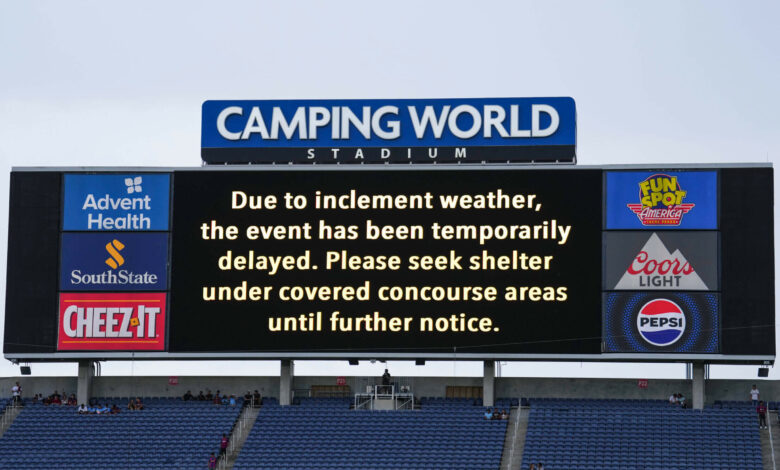A World Cup in America in the middle of summer? Have they had enough again?

It was the US’s much-vaunted summer of soccer, but it was also a stress test for the country hosting the World Cup.
There was certainly enough stress to test.
In addition to concerns about on-field conditions, crowd control and security (which were alarmingly exposed just before the Copa America final in Miami, when ticketless fans forced their way into the stadium), Mother Nature provided many more challenges.
Extreme weather, ranging from scorching heat to torrential rain and lightning, forced the postponement of matches at the Copa America and several European club tours, leaving fans, officials and players struggling to cope with the aftermath.
Some meteorologists believe that FIFA, the body that organises world football, should prioritise climate change issues, and questions are being raised about the feasibility of holding major tournaments in the summer.
“There needs to be a conversation about holding these games in places where summer temperatures are above 90 degrees Fahrenheit,” said Dan DePodwin, AccuWeather’s senior director of forecasting operations. “Should games be played in Miami in July? I don’t know the answer, but it’s a question worth asking.”
Just this week, Barcelona’s crucial friendly against Manchester City in Orlando was postponed by 80 minutes due to storms.
Fans had to take shelter under the stands of the Camping World Stadium before the match finally kicked off, and afterwards Barcelona manager Hansi Flick said: “The conditions were not optimal because of the weather.”
City’s first match of their US tour, a 4-3 defeat to Celtic, was also affected by fans being forced to leave Kenan Stadium in North Carolina after a weather warning was issued hours before kick-off. However, the match was not delayed.

Fans in North Carolina were evacuated before Manchester City played Celtic (Peter Zay/AFP/Getty Images)
On Sunday, kick-off of another match in Florida, between Wolves and West Ham, was also delayed by more than two hours as thunderstorms battered downtown Jacksonville, prompting a flash flood warning for the city.
The heat was a problem during the Copa America. During a group stage match on June 25 between Canada and Peru at Children’s Mercy Park in Kansas City, one of the assistant referees, Humberto Panjoj, collapsed.
The Guatemalan was standing on the side of the pitch, in the sun, during the closing stages of the first half, which had started at 5 p.m. When the temperature rose to almost 37.8 degrees Celsius and the humidity was 50 percent, he fainted and was carried off on a stretcher.
Panjoj was rushed to hospital and released a day later with what tournament organizers CONMEBOL described as dehydration. Even fans who normally fill the Cauldron section of the stadium had moved en masse to shaded stands to avoid the blazing sun, the Kansas City Star reported.
Two days earlier, Uruguayan defender Ronald Araujo was forced to leave the field during his team’s 3-1 win over Panama due to heat-related problems. Araujo reported feeling dizzy and his blood pressure had dropped.
“The truth is that I’m still a bit dizzy now,” the 25-year-old said afterwards. “My (blood) pressure went down. When the first half was over, I was a bit dizzy and when I got to the locker room, my pressure went down. The doctor said it was a bit of dehydration and that I couldn’t continue in the second half.”
It also affected the teams’ preparation. Paraguay manager Daniel Garnero described the heat during training as “oppressive”, adding: “The sun is really intense and it sets very late, so we have had to adapt our training schedule. The demands of these temperatures do not help us.”
Before Brazil’s 4-1 win over Paraguay at Allegiant Stadium in Las Vegas, the team was scheduled to practice at 5 p.m. at the Bettye Wilson Soccer Complex. It was so hot that they postponed it for two hours, considering canceling the session altogether in favor of the players working out in the gym. When practice began, the sprinklers on the grass remained on the entire time.
“We went from the parking lot to the stadium and the temperature change was incredible,” said central defender Marquinhos. “A stadium with air conditioning will really help the game because it’s very hot here. It could be a factor in our favor because it’s a bit cooler.”
“It’s really hot,” added left-back Guilherme Arana. “I got off the plane and it was that sultry heat. We follow the recommendations of the nutritionists and physiotherapists and hydrate a lot.”

Canadian Maxime Crepeau helps assistant referee Humberto Panjoj in Kansas (Jamie Squire/Getty Images)
CONMEBOL described the impact of global warming on the health of athletes as “a critical issue” and said that “rising temperatures due to climate change pose a significant threat to players”.
The organizing body has issued a series of guidelines to address exertional heat stroke in football. These include medical screenings to identify players at risk of heat stroke, a recommendation that players be allowed to acclimatize to the heat gradually over 10-14 days, and an emphasis on the importance of hydration and sleep.

GO DEEPER
Explained: How the Copa America deals with ‘oppressive’ heat
“There’s a reason they play football in the fall,” says DePodwin, who leads a team of 45 AccuWeather meteorologists from the company’s headquarters in Pennsylvania. The organization advises half of the Fortune 500 and provides forecasts to millions of people through its website and app.
“It’s been a very hot summer in the US and I think it will be one of the hottest ever,” he says. “It’s certainly a global trend for much hotter periods, but the Copa America will give more visibility to how we are affected in the US. A lot of the places where they played games get extremely hot and while a lot of stadiums had retractable roofs, not all did.”
High humidity, DePodwin says, has amplified the effect of those rising temperatures. It’s one of the elements AccuWeather uses in its “Real Feel” rankings, which also include temperature, wind speed and sun angle to provide a more comprehensive forecast of what the weather will actually feel like.
“There are plenty of afternoons in Miami, where they played the final, where it’s actually 38 degrees,” he says.
DePodwin says it would help to start games in the morning or late at night. “But we know that in the group stage of a tournament like the World Cup, that’s not always possible.”
Regardless, he says lessons need to be learned from this summer, particularly by venues that hosted matches and will host the Club World Cup or the 2026 World Cup again next summer. “It’s important that these venues have a plan in place to deal with heat and thunderstorms, which also bring lightning, damaging winds and rain.
“There are certainly risks of further delays or postponements. FIFA needs to think about the efforts athletes have to make in those circumstances, but also about other places, such as how fans in fan parks and pre-match gatherings are vulnerable to the elements.”

Rain delays Manchester City’s match against Barcelona in Orlando (Rich Storry/Getty Images)
Another potential hazard could be poor air quality. “There have been many occasions in recent years where wildfire smoke has caused hazardous air quality in parts of the United States,” he adds. “For example, in June 2023, there were multiple days of hazardous air quality in the northeastern U.S., causing many sporting events and other outdoor activities to be canceled.
“If a similar situation were to occur during the World Cup, there could be delays or cancellations.”
Does he also believe that major tournaments should be held more often at times other than in the summer, such as the 2022 World Cup in Qatar?
“It’s an interesting topic of discussion,” he says. “Even if the World Cup starts in September, that would help, but then of course it would impact all the domestic seasons of each country.”
Asked about the impact of the weather ahead of the World Cup, a FIFA spokesperson said The Athletics: “We have studied extensive historical weather data during our planning efforts and will continue to monitor weather trends through 2026.
“As noted earlier this year when announcing the fixture list, FIFA will seek to increase the prospects of favourable playing and spectator conditions for teams and fans (taking into account factors such as heat forecasts for example) through kick-off times, which will be added after the final draw in late 2025.”
Even their opponents would admit that FIFA can’t control the weather. But like all other stakeholders who want the 2026 World Cup to be a resounding success, there will be a lot of planning involved.

GO DEEPER
The science behind an air-conditioned World Cup: Dr. Cool, Ford Mondeos and airplane wings
(Top photo: The scoreboard at Camping World Stadium before Manchester City vs. Barcelona in Orlando, Florida; by Rich Storry via Getty Images)




